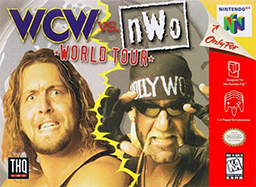
WCW vs. nWo: World Tour is a professional wrestling video game released in 1997 for the Nintendo 64 game console. Released at the peak of World Championship Wrestling's (WCW) dominance in the Monday Night War, World Tour was THQ's first foray into the N64 wrestling scene and is a semi-sequel to the lesser known WCW vs. the World for the PlayStation. It is the second best-selling wrestling game for the N64 console.

WWF WrestleMania 2000 is a professional wrestling video game released in 1999 on the Nintendo 64 (N64) console. It was based on the World Wrestling Federation's annual pay-per-view, WrestleMania. Despite the fact that this game is based upon WrestleMania 2000, the game was released five months prior to the actual PPV itself, therefore resulting in the game using the stage design from the 1999 event, WrestleMania XV, instead. Released at the height of the WWF's Attitude Era, WrestleMania 2000 was the first WWF game released by THQ. The wrestling company ended its long relationship with Acclaim Entertainment after witnessing the video game success of its competitor, World Championship Wrestling (WCW), on behalf of THQ. WrestleMania 2000 shares its game engine with the Japan-only release Virtual Pro Wrestling 2: Ōdō Keishō.

WWF No Mercy is a professional wrestling video game released in 2000 by THQ for the Nintendo 64. It is based on the World Wrestling Federation and is named after the company's annual event of the same name. Developed by Asmik Ace Entertainment and AKI Corporation, No Mercy is the last in a series of Nintendo 64 wrestling games from the companies that started with WCW vs. nWo: World Tour.

Vigilante 8 is a vehicular combat video game developed by Luxoflux and published by Activision for PlayStation, Nintendo 64, and Game Boy Color. Although officially it has no connection to the Interstate '76 series, it features several of its themes.

BattleTanx: Global Assault is an action game developed and published by The 3DO Company for the Nintendo 64 and PlayStation, in which players control futuristic tanks in a post-apocalyptic scenario. It is a sequel to the Nintendo 64 game BattleTanx, which utilized the same method of game play. Although it earned relatively positive reviews from critics, 3DO went bankrupt before another sequel could be released.

Madden NFL 99 is a football video game released for the PlayStation, Nintendo 64 and Microsoft Windows. It is the first multiplatform Madden game to be fully 3D and polygonally based and is also the first game to feature Franchise mode. The game's commentary is by John Madden and Pat Summerall. The American version of the game features John Madden himself on the cover, while the European version uses Garrison Hearst instead. The game was the top-selling PlayStation sports video game in 1998 in North America, having sold 1.1 million copies on the PlayStation.

Madden NFL 2000 is a football video game. This was the second of the Madden NFL games to not solely feature John Madden on the cover in North America. The only other one was Madden NFL '95. Most versions of the game cover featured Madden prominently in the foreground, and a recognizable Barry Sanders in a background action graphic. The European PAL edition features only Dorsey Levens on the cover.

Hydro Thunder is an arcade inshore powerboat racing video game originally released by Midway Games in February 1999 and later released for the Sega Dreamcast as a launch title later that year. It was also released for the PlayStation and Nintendo 64 in early 2000. This game is part of Midway's Thunder series of racing games, which includes Offroad Thunder, 4 Wheel Thunder, and Arctic Thunder. Hydro Thunder Hurricane, a sequel to Hydro Thunder, was later released for the Xbox 360 on July 27, 2010 on Xbox Live Arcade.

WCW Mayhem is a professional wrestling video game published by Electronic Arts (EA), based on the American promotion World Championship Wrestling (WCW). The first WCW game produced by EA, it was released for Nintendo 64 and PlayStation in 1999 and for the Game Boy Color the following year.

WWF War Zone is a professional wrestling video game developed by Iguana West and released by Acclaim Entertainment in 1998 for the PlayStation, Nintendo 64, and Game Boy. The game features wrestlers from the World Wrestling Federation.

WWF Attitude is a professional wrestling video game based on the World Wrestling Federation released by Acclaim Entertainment in 1999 for the PlayStation and Nintendo 64. A slightly enhanced port of the game was later released for the Dreamcast, as well as a handheld version for the Game Boy Color. The game is named after the WWF's then-current "Attitude" marketing campaign, with the tagline "Get it" also being used on company programming during that period.

ECW Hardcore Revolution is a professional wrestling video game released by Acclaim Entertainment, based on the professional wrestling promotion Extreme Championship Wrestling (ECW). The game was released for the Nintendo 64, PlayStation, Game Boy Color, and Dreamcast in 2000. It was the first wrestling game to be based on ECW, as well as the first professional wrestling video game to receive a Mature rating from the ESRB, although the Game Boy Color version was rated Everyone. Acclaim followed this title with the release of a sequel, ECW Anarchy Rulz, in August 2000.
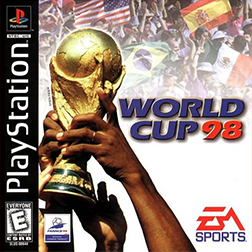
World Cup 98 is a football video game released in 1998 to coincide with that year's FIFA World Cup football tournament, developed by EA Canada and published by Electronic Arts under their EA Sports label. It is the first official FIFA World Cup game developed by EA Sports after obtaining the rights from FIFA in 1997. Unlike the previous World Cup games, which were in 2D and showed a bird's-eye view, World Cup 98 used a 3D engine, utilising DirectX for the PC version.
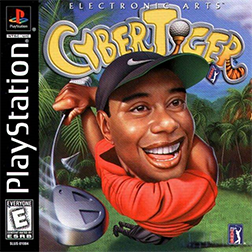
CyberTiger is a 1999 golf video game featuring Tiger Woods, for PlayStation, Nintendo 64 and Game Boy Color. Woods is the main opponent and best-rated player in the game.
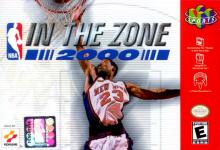
NBA In The Zone 2000 is a basketball video game released for the Nintendo 64, PlayStation, and Game Boy Color in 2000. It is the fifth and final installment of the NBA In The Zone series. The cover features Marcus Camby of the New York Knicks.

Polaris SnoCross is a snocross snowmobile racing game for Game Boy Color, PlayStation, Nintendo 64, and later Microsoft Windows. It was released in 2000. French publisher Wanadoo Edition released a budget version of the game for the PC in 2001, called SnowCross.

Supercross 2000 is a 3D racing game based on the sport of Supercross. It was published by EA Sports for PlayStation and Nintendo 64 consoles in North America on October 31, 1999, and in Europe in February 2000. Its sequel, Supercross, was released in November 2000.

Army Men: Sarge's Heroes 2 is a third-person shooter video game developed and published by The 3DO Company for Nintendo 64, Game Boy Color, PlayStation and PlayStation 2. The game is a direct sequel to Army Men: Sarge's Heroes. Unlike the previous game which was more dark in tone, this game has more of a lighthearted storyline.
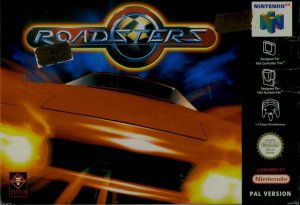
Roadsters is a racing game released by Titus Software for Nintendo 64 in 1999, and for PlayStation, Dreamcast and Game Boy Color in 2000. It is a car racing game that features both licensed cars from manufacturers and unlicensed cars from imaginary manufacturers that are based on and bear great resemblance to their equivalent, real car models. The game also includes a multi-player mode supports up to 2 human players that can compete in any of the available circuits with 4 more CPU controlled racers. A PlayStation 2 version was originally planned to release on April 11, 2001.

NFL Blitz 2001 is a video game developed and published by Midway for the Dreamcast, PlayStation, Nintendo 64 and Game Boy Color in 2000.



















